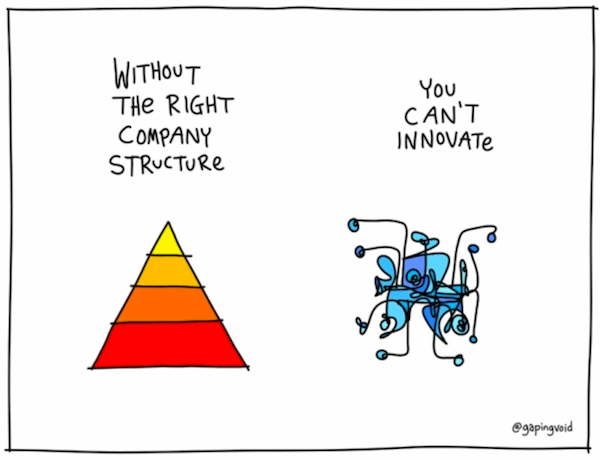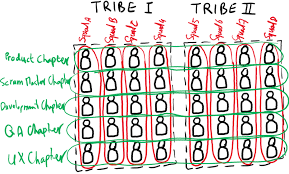When we think of organizations, we often picture bustling offices, teams working in sync, and goals being met through collaboration and innovation. However, behind every successful enterprise lies an often unseen yet crucial element: the business organization chart.
It is the framework that defines how activities such as task allocation, coordination, and supervision are directed toward achieving organizational goals.
In this blog, we explore the various types of organizational structures, their benefits and drawbacks, and how they influence business operations. We will also explore real-world examples to highlight the importance of choosing the right structure for your organization.
Introduction to organizational structures
Organizational structure determines how roles, power, and responsibilities are assigned, controlled, and coordinated and how information flows between the different levels of management.
This structure is typically depicted on an organizational chart because an organization’s structure can significantly impact its efficiency, culture, and success.
Key Components of a business organization chart
- Hierarchy Levels: The layers of authority and responsibility within the organization.
- Reporting Line: The number of subordinates a manager or supervisor directly relates to.
- Departmentalization: How the organization is divided into departments or divisions.
- Centralization vs. Decentralization: The degree to which decision-making authority is concentrated at higher levels or distributed throughout lower levels.
- Responsibility
The REAL Importance of Organizational Structure
A survey conducted by Deloitte found that 92% of executives believe that redesigning the organization is critical to driving success in the digital age.
Choosing the right organizational structure is key to staying competitive and agile. The REAL importance and benefit of creating a great organizational structure and chart is not just about titles. In order to be truly beneficial, it’s essential to plot responsibilities, giving each member of the team accountability.
- For process planning in the business
- To support new employees
- For onboarding and training
- To outline cross-functional relationships
- As a decision-making tool
What is the purpose of a business organization chart?
Organizational culture refers to the shared values, beliefs, and practices that characterize an organization. It is closely tied to organizational structure and can significantly impact its effectiveness.
- Communication: A well-defined structure facilitates clear communication channels, enhancing transparency and collaboration.
- Employee Satisfaction: An appropriate structure can improve job satisfaction by providing clear roles, responsibilities, and career paths.
- Innovation: Certain structures, like matrix or flat structures, can foster innovation by encouraging collaboration and flexibility.
Types of Organizational Structures
1. Functional Structure
In a functional structure, the organization is divided into departments based on specific functions such as marketing, finance, human resources, and production. Each department is managed by a specialist in that area.
Advantages:
- Specialization: Employees become highly skilled in their specific functions.
- Efficiency: Clear roles and responsibilities lead to operational efficiency.
Disadvantages:
- Silo Mentality: Departments may become isolated from one another, leading to communication breakdowns.
- Inflexibility: Can be slow to adapt to changes in the market or environment.
Example: A typical functional structure can be seen in many traditional manufacturing companies, where departments such as production, sales, and finance operate independently under a centralized command.
2. Flat Structure
In a functional structure, the organization is divided into departments based on specific functions such as marketing, finance, human resources, and production. Each department is managed by a specialist in that area.
Advantages:
- Specialization: Employees become highly skilled in their specific functions.
- Efficiency: Clear roles and responsibilities lead to operational efficiency.
Disadvantages:
- Silo Mentality: Departments may become isolated from one another, leading to communication breakdowns.
- Inflexibility: Can be slow to adapt to changes in the market or environment.
Example: A typical functional structure can be seen in many traditional manufacturing companies, where departments such as production, sales, and finance operate independently under a centralized command.
3. Divisional Structure
A divisional structure groups each organizational function into a division. Each division operates as a semi-autonomous entity with its own resources and objectives. Divisions can be based on product lines, geographies, or markets.
Advantages:
- Focus: Divisions can focus on specific markets or products, enhancing responsiveness.
- Accountability: Easier to track the performance of each division.
Disadvantages:
- Duplication: Resources and efforts may be duplicated across divisions.
- Competition: Divisions may compete against each other for resources and attention.
Example: General Electric (GE) is a classic example of a company with a divisional structure, where each division focuses on different industries such as aviation, healthcare, and energy.
4. Matrix Structure
A matrix structure combines functional and divisional structures, creating a grid of reporting relationships. Employees have dual reporting relationships – generally to both a functional manager and a project manager.
Advantages:
- Flexibility: Can respond quickly to changes and new projects.
- Resource Efficiency: Efficient use of resources across projects and functions.
Disadvantages:
- Complexity: This can lead to confusion and conflict due to dual reporting lines.
- Power Struggles: Managers may compete for authority and resources.
Example: Many consulting firms and tech companies, like IBM, use a matrix structure to balance project-based work with functional expertise.
5. Network Structure
In a network structure, the organization retains its core functions and outsources non-core activities to other organizations. This creates a network of relationships that supports the main organization.
Advantages:
- Flexibility: Can quickly adapt to changes by leveraging external partnerships.
- Focus: Allows the organization to concentrate on its core competencies.
Disadvantages:
- Dependency: Heavy reliance on external partners can be risky.
- Control: Maintaining quality and consistency across partners can be challenging.
Example: Companies like Nike use a network structure, outsourcing manufacturing while focusing on design and marketing.
How to choose the right business structure?
Choosing the right organizational structure is critical for the success of any business. Here are some factors to consider:
- Size of the Organization: Larger organizations may benefit from a divisional structure, while smaller companies may thrive with a flat or functional structure.
- Nature of the Business: The complexity and diversity of products or services can influence the choice of structure.
- Business Strategy: The organizational structure should align with the company’s strategic goals and objectives.
- Culture and Values: The structure should reflect and support the company’s culture and values.
The impact of organizational structure on performance
A well-chosen organizational structure can lead to improved efficiency, better communication, and enhanced employee morale. Conversely, a poorly chosen structure can result in confusion, inefficiency, and decreased performance.
Real-World Example: Apple’s Organizational Structure
Apple Inc. provides a compelling example of how organizational structure can influence business success. Under Steve Jobs, Apple adopted a functional structure that emphasized specialization and expertise. This structure allowed Apple to innovate rapidly and maintain high-quality standards across its product lines. As of 2021, Apple retained a modified functional structure with more collaboration between departments, reflecting its need to integrate hardware, software, and services seamlessly.
Another example is Spotify’s Organizational Structure
The tribes model designed by Spotify is a blueprint for organizational agility created from the company’s own ethos, values, and structural DNA, designed to keep the wheels of innovation churning. It however is fairly complex and applies to large teams only.
How to plot your business organization chart?
First, it’s important to understand the difference between an organizational chart and an organizational structure.
An organizational chart is based on people, while an organizational structure is based on functions.
Organizational structures outline the responsibility, accountability, and authority for each role in the company. And they don’t change often.
The most strategic way to view your organizational structure is to use a organizational chart maker that allows you to add responsibilities so you create the ultimate accountability chart.
FAQs on the business organization chart
What are the 4 types of Organisational structures?
The 4 types of organizational structures include;
- Flat
- Matrix
- Divisional
- Functional
But there are additional structures for specialist use cases such as the Spotify tribes structure.
Which organizational structure is best?
The best structure is the one that fits your organization.
When creating an organizational structure, consider the future vision of the company and what responsibilities you want your team members to carry. (Rather than considering just seats!).
Bottom line?
Understanding and choosing the right organizational structure is vital for the success and growth of any business. It not only defines the framework within which the organization operates but also influences its culture, efficiency, and ability to adapt to changes. By carefully considering the various types of structures and their implications, businesses can create an environment that supports their strategic goals and fosters innovation and growth.
Whether you are a startup looking to establish a dynamic and flexible structure, or a large corporation aiming to streamline operations and enhance accountability, the right organizational structure can be a powerful tool in achieving your business objectives. So, take the time to evaluate your options, consider your unique needs, and build a structure that will support your journey to success.










